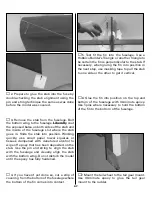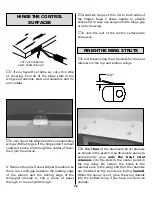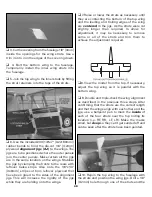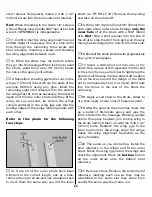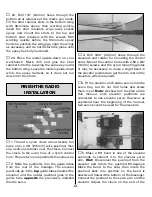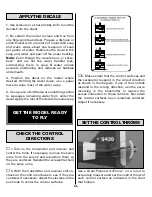
❏
3.
Be certain the battery and receiver are
securely mounted in the fuse. Simply
stuffing them into place with foam
rubber is not sufficient.
❏
4.
Extend the receiver antenna and make
sure it has a strain relief inside the
fuselage to keep tension off the solder
joint inside the receiver.
❏
5.
Balance the model
laterally as explained
in the instructions.
❏
6.
Use thread locking compound to secure
critical fasteners such as the set screws
in the wheel collars, screws that hold the
carburetor arm (if applicable), screw-lock
pushrod connectors, etc.
❏
7.
Add a drop of oil to the axles so the
wheels will turn freely.
❏
8.
Make sure all hinges are
securely
glued
in place.
❏
9.
Reinforce holes for wood screws with
thin CA where appropriate (servo
mounting
screws,
cowl
mounting
screws, etc.).
❏
10. Confirm that all controls operate in the
correct direction and the throws are set
up according to the manual.
❏
11. Make sure there are silicone retainers on
all the clevises and that all servo arms
are secured to the servos with the screws
included with your radio.
❏
12. Secure connections between servo wires
and Y-connectors or servo extensions,
and the connection between your battery
pack and the on/off switch with vinyl
tape, heat shrink tubing or special clips
suitable for that purpose.
❏
13. Make sure any servo extension cords you
may have used do not interfere with
other systems (servo arms, pushrods, etc.).
❏
14. Secure the pressure tap (if used) to the
muffler with high temp RTV silicone,
thread locking compound or J.B. Weld.
❏
15. Make sure the fuel lines are connected
and are not kinked.
❏
16. Use an incidence meter to check the wing
for twists and attempt to correct before
flying.
❏
17. Balance your propeller (and spare
propellers).
❏
18. Tighten the propeller nut and spinner.
❏
19. Place your name, address, AMA number
and telephone number on or inside your
model.
❏
20. Cycle the receiver battery pack (if
necessary) and make sure it is fully
charged.
❏
21. If you wish to photograph the model, do
so before the first flight.
❏
22. Range check your radio when you get to
the flying field.
The Dynaflite S.E.5a is a great-flying model that
flies smoothly and predictably. The S.E.5a does
not, however, possess the self-recovery
characteristics of a primary R/C trainer and
should be flown only by experienced R/C pilots.
A fully cowled engine may run at a higher
temperature than an un-cowled engine. For this
reason, the fuel mixture should be richened so
the engine runs at about 200 rpm below peak
speed. By running the engine slightly rich, you
will help prevent dead-stick landings caused by
overheating.
FUEL MIXTURE ADJUSTMENTS
FLYING
61
Summary of Contents for Dynaflite S.E.5a
Page 9: ...9 Die Drawing...
Page 10: ...10 Die Drawing...

